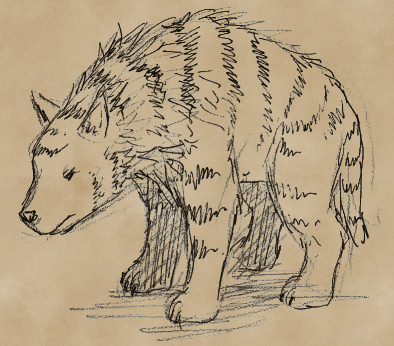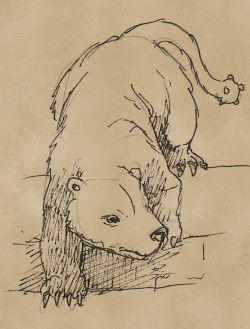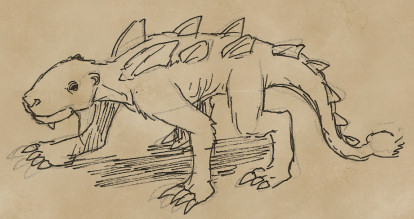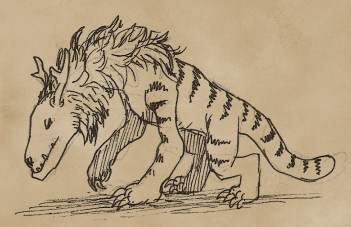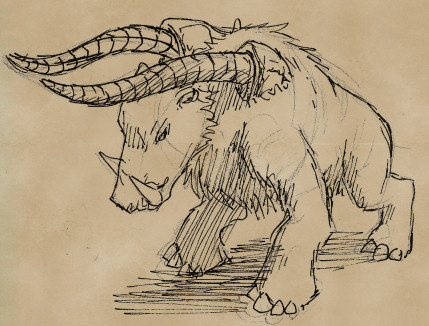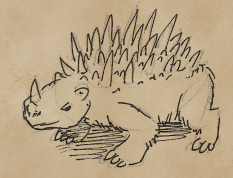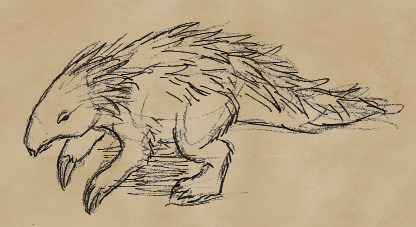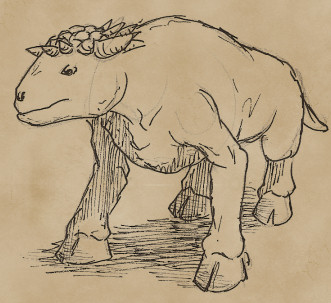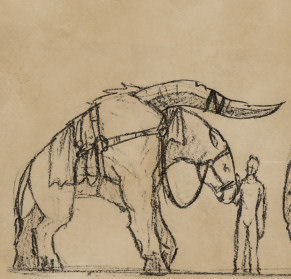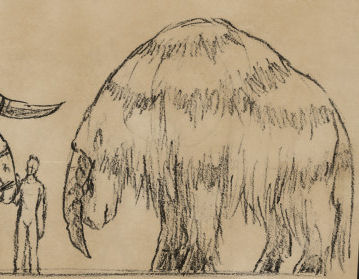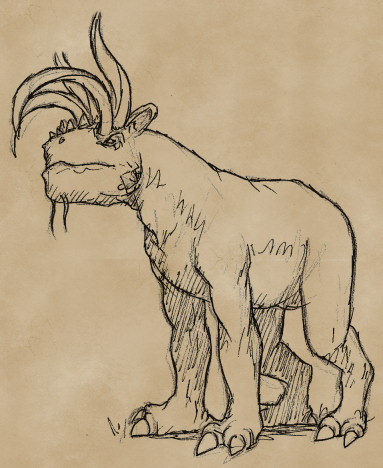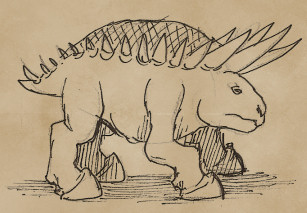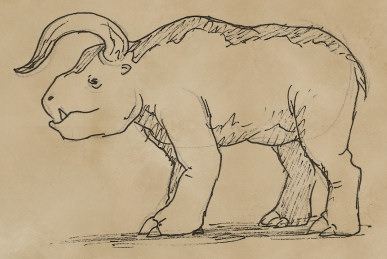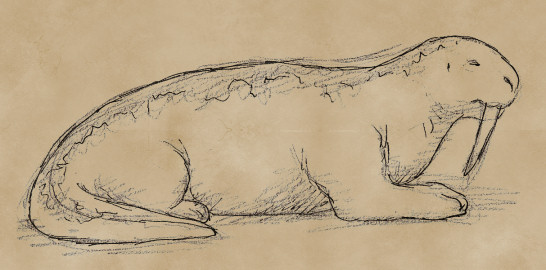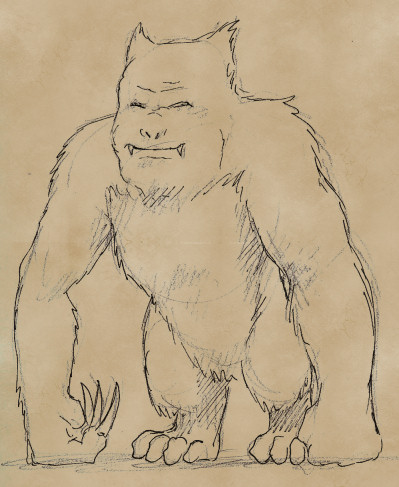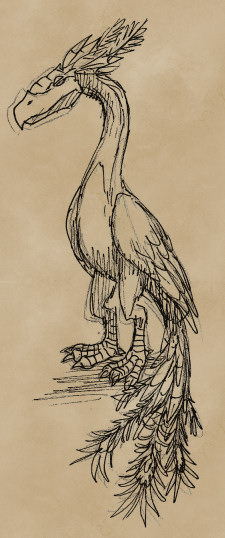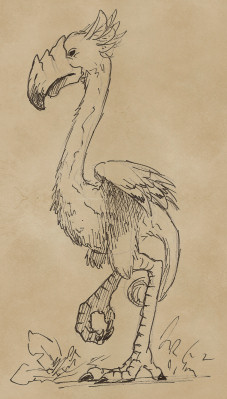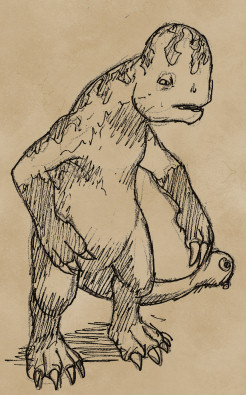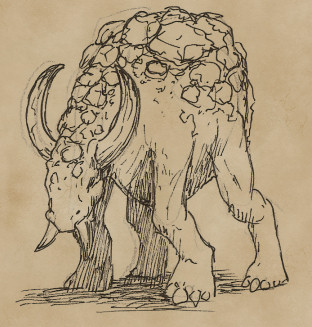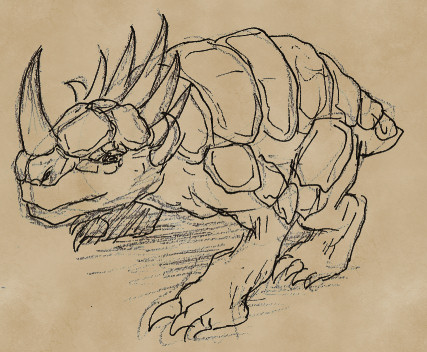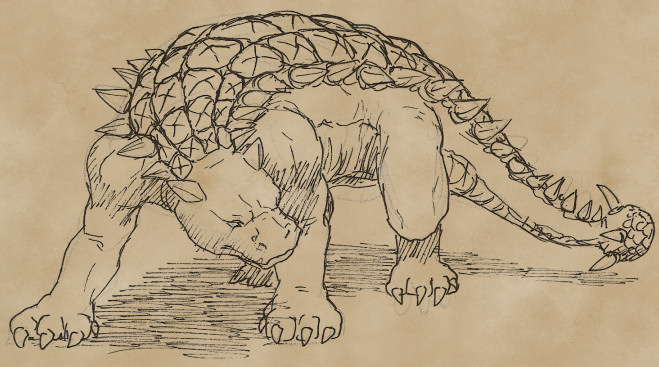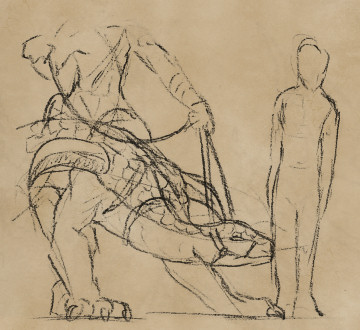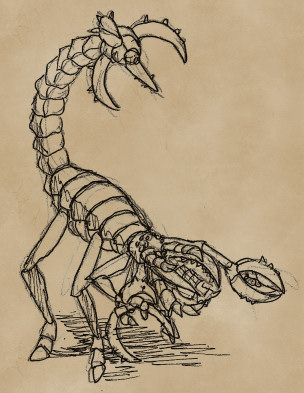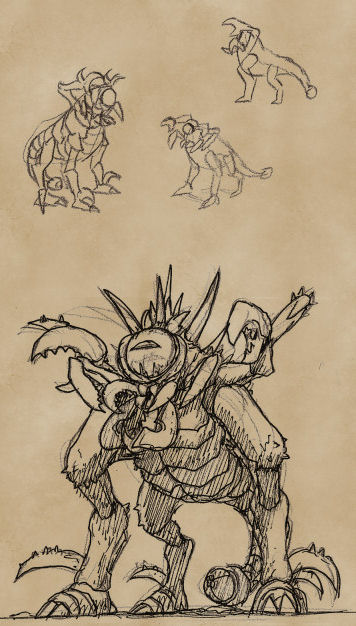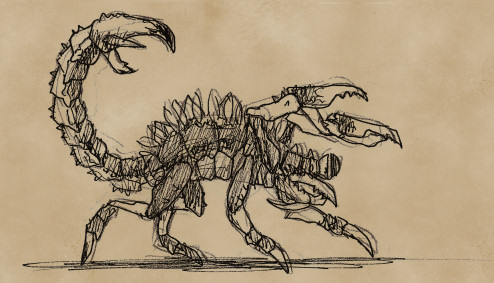Uniquefauna: Difference between revisions
No edit summary |
|||
| (42 intermediate revisions by the same user not shown) | |||
| Line 1: | Line 1: | ||
= | = Mammals = | ||
== Canine == | |||
===Dograt=== | |||
===Enena=== | |||
[[File:Enena.jpg]] | |||
Burtu | Enenas are native to the grasslands surrounding the Ebere Desert of Baracsa, the Qarar desert. Considered a cross between a bear and a wolf, enenas hunt in groups. They are known for being able to open turtle shells using the sheer power of their jaws and teeth, and will kill and eat almost anything they can. They live in social herds with complex hierarchical systems. | ||
The ruenena, also known as the snow enena, is native to the Khatsanaras in Armalia. They live in cold, grassy plains and hunt birds rather than larger animals and they have a distinct greyish-white coat. They are also smaller and stockier than their desert-dwelling relations. | |||
===Huim=== | |||
[[File:Huim.jpg]] | |||
Huims live in north-eastern Suribia and can be found in forests and mountains around the Vaman Sea. They look like bears but have larger heads and long tails with a spiky, bony club on the end. They are much than most kinds of bears and are known to kill smaller bears. They stand on hind legs and growl to show dominance and will hunt anything that smells good enough for them. Mature huims lead solitary lives but do not hibernate and do not have dens. Although the bony club on their tail has never been swung as a weapon, their large claws and strong jaws make them sufficiently formidable. | |||
== Feline == | |||
===Harce=== | |||
[[File:Harce.jpg]] | |||
Harce are cat-like creatures found only on the island of Teruvas. They are adapt at keeping still and camouflaging with their surroundings, enabling them to hunt smaller prey and hide from larger predators. They have a second set of translucent eyelids which allows them to avoid blinking, as the extra eyelids keep the eyes moist, and their large, sturdy rib cages mean they can breathe without it being seen. The bony finds down its back are thought to collect heat while static to keep its body warm without needing to move. The long whiskers coming from the sides of its mouth are thought to feel movement in the air. It is said that a harce can lie in wait for ten years. | |||
Harce hunt alone in the aforementioned manner and sometimes prowl to stalk nearby prey. They normally eat rodents, rabbits, and birds. They have many teeth and has claws that cannot retract, making anything faster than a walk impractical. | |||
===Runtan=== | |||
[[File:Runtan.jpg]] | |||
Runtans are found in the Pzenkarl Basin of Jindiara. They have a protruding lower jaw and long, strong, flexible necks covered with a messy mane. Males boast short antlers which they use for battling other males for dominance. They roar or snap their jaws to intimidate or show irritation. Save the mother-cub relationship, they mostly lead solitary lives, and males fight for rulership of small portions of the jungle. Natives say the only way to outsmart a runtan is to exploit its rapid response time by luring it into a trap. | |||
They rely on small bursts of energy to catch prey and are known to jump more than 15 meters across and 5 meters upward in a single bound. | |||
===Tlenlion=== | |||
== Antlered == | |||
===Cruxgoat=== | |||
===Karathas=== | |||
===Onuxutex=== | |||
== Horned/Spiked == | |||
===Behemoth=== | |||
===Burtu=== | |||
[[File:Burtu.jpg]] | |||
Burtu are native to the Sacres Plains and Green Ranges of Suribia. They are similar to a nortu in that they have horns protruding from their shoulders, but are omnivorous, have clawed pads for feet, and have large tusks, while nortu are herbivorous, have hooves, and do not have tusks. The horns are also ribbed, also unlike those of nortu. Most burtu are smaller than nortu but there are stories of burtu as big as bulls. | |||
Male burtu fight each other using their horns and tusks. They normally fight over mating rights but sometimes seem to do it more gently for entertainment. They live in small herds of around a dozen and seem to respect relationships like parent, child, sibling, friend, rival, playmate, foraging partner, and so on. They normally eat grasses and roots but will eat rodents, small birds, or anything else edible that's placed in front of them. | |||
===Herin=== | |||
[[File:Herin.jpg]] | |||
Herins are found in the Pearl Mountains, Pitan Plains, and Vaman Ranges. They have tough bodies covered in spines of varying length and a single small horn on the snout. A herin can raise its spines from its back by curving its body. Though often shorter than a leg, they are capable of sudden bursts of speed. | |||
They forage on roots, seeds, grubs, ants, and beetles. They live in large communities of scattered and changeable dynamics. They gurgle if disturbed but often hide if anything larger comes near them, though they will bite with sharp teeth if cornered, often tearing flesh and causing infections. The quills are also sharp and can pierce leather if handled poorly. | |||
===Kureter=== | |||
[[File:Kureter.jpg]] | |||
Kureters are found around the Totani Sea in places like the Coral Mountains, Satium Coast, and east of the Atlis. They live in burrows which they dig out with their powerful claws and grow to around a meter in length. They walk on their hind legs and balance with their large, heavy tails. It uses its superior sense of smell to find food and spends most of the night eating so that it can sleep underground during the day. It is therefore disturbed by bright lights. | |||
They click to talk to one another and will scratch in self defence, but if they are threatened as a group they are known to basically shred an invader to pieces. Some people carry certain repellents on them when they travel through these places at night in fear of kureter attacks. | |||
===Mavara=== | |||
[[File:Mavara.jpg]] | |||
Mavara are native to the Amber Plains and the Diamond Hills. The former are called amber mavaras and the latter are usually just called mavaras. They live in large herds and have white or grey (or cream in the case of amber mavaras) fur. They are known for their crown consisting of short ridged horns surrounding a bony cap. They graze and wander and are normally docile enough to be tamed, but will anger quickly if threatened. They snort and stamp their feet before lowering their head and raising the shoulders to display the bony crown. They are said to be fearless and will charge and trample anything that refuses to back away. They are often used as a symbol of courage among natives. | |||
There are stories of herds of mavara bulls that normally roam far from any people, but occasionally they will wander near a village and trample houses and maul people before leaving as quickly as they came. These events are known as "crowned storms" in various languages. | |||
===Nortu=== | |||
[[File:Nortu2.jpg]] | |||
Nortu live around the Bay of Teman. They live in large herds and have horns or spines growing forward from their shoulders. They are larger than domestic cattle and graze in large groups led by dominant bulls. Nondominant bulls roam alone but will sometimes form small temporary groups in which they protect one another against larger predators. Though they don't normally attack people, a startled herd can rampage unstoppably, crushing everything in their path. They use their large horns to fight for dominance and can duel for many hours. Defeat is normally the result of exhaustion rather than of injuries. | |||
===Nuinrari=== | |||
[[File:Nuinrari2.jpg]] | |||
The nuinrari is a mighty beast found only on Vras Qran, north of the Batyr Sea. Little is known about these huge creatures. They can be up to five meters tall and have very long fur that turns whiter when a blizzard approaches. The horns of a nuinrari grow forwards and they use these horns for shovelling snow to look for plants, roots, or moss beneath surface. They seem to wander in small groups with no care for territory. | |||
===Yrmbaro=== | |||
[[File:Yrmbaro.jpg]] | |||
The yrmbaro are found around Yrtkuam but are known to live further north in the Simbean Desert or west in the Ebere Desert. They are colossal creatures, often reaching eight or nine meters top toe to horn, disregarding the fact that they can stand on their hind legs. They can be tamed but their long life cycles and solitary nature make them impossible to domesticate. Male yrmbaro have four horns and females have only two. One horn alone can weigh up to 200kg, and the entire beast can weigh around seven tons. They are slow, bulky, cumbersome animals and normally move slowly and peacefully, devouring all fauna they come across. They use their two root-like whiskers to taste what's on the ground before going to the effort of eating it. The rocky patches on the base of their jaws is said to develop because they rub it against stones. It's not known why they do this. They are also known to eat rocks and sand as though it's any other food. | |||
Yrmbaro have glistening hides, presumably because of all the shining sand they eat when the herds make their rare trips to the Glasslands east of Yrtkuam. Battles between two yrmbaro bulls can last days -- often starting with stomping and vocalising, and ending in ramming one another until one falls over from exhaustion, and their bellows can be heard as far as the horizon. They are only mildly aggressive given their size and strength, but have been utilised in battle by the Karithians in the past. | |||
== Plated == | |||
===Garukoth=== | |||
[[File:Garukoth.jpg]] | |||
===''Glyptodon''=== | |||
== Tusked == | |||
===Cullas=== | |||
===''Daeodon''=== | |||
===Raxl=== | |||
[[File:Raxl.jpg]] | |||
===Terupi=== | |||
[[File:Terupi.jpg]] | |||
== Primate == | |||
===Evora=== | |||
[[File:Evora.jpg]] | |||
===Rock Evora=== | |||
===White Evora=== | |||
= Birds = | |||
==Flightless== | |||
===Coatl=== | |||
[[File:Coatl.jpg]] | |||
===Kerumitna=== | |||
[[File:Kerumitna.jpg]] | |||
===''Quetzalcaotlus''=== | |||
==Flying== | |||
===Argentavis=== | |||
===''Confuciusornis''=== | |||
===''Eudimorphodon''=== | |||
===''Gastornis''=== | |||
===''Ornithocheirus''=== | |||
===''Pterodactylus''=== | |||
===''Rhamphorhynchus''=== | |||
= Reptiles = | |||
== Bipedal == | |||
===Bodhesor=== | |||
[[File:Bodhesor.jpg]] | |||
===''Aucasaurus''=== | |||
===''Giganotosaurus''=== | |||
===''Parasaurolophus''=== | |||
===''Tarbosaurus''=== | |||
== Quadrupedal == | |||
===Blue Cmarla=== | |||
===Cmarla=== | |||
[[File:Cmarla.jpg]] | [[File:Cmarla.jpg]] | ||
===''Effigia''=== | |||
===Kimai=== | |||
===Megalania=== | |||
===Oornthl=== | |||
[[File:Oornthl.jpg]] | |||
===Orcanor=== | |||
[[File:Orcanor.jpg]] | |||
Orcanor are elephant-sized reptiles which have been tamed for thousands of years in northern Baracsa. They can reach ten meters in length and can weigh up to eight tons. They have armoured backs covered in bony materail, short and stocky legs, a square skull, and a clubbed tail. Though normally calm and hard to startle, they are powerful enough to tear a man in half with a single bite. Threatened orcanor arch their backs and curling around the threat, such as in the image, and will also growl loudly, but few creatures can cause this reaction from an orcanor. | |||
Orcanor eat grasses, moss, reeds, and sometimes wood. They aren't fussy eaters, and are very good at carrying many times their own weight. They are also said to be able to sleep for months, or go weeks without sleep. They live in herds of a few dozen, led by the largest and strongest male, and can live up to three centuries. | |||
Due to their strength, their non-fussy eating habits, their placidity, and their tameness, they are the beast used to pull [[Trains]]. Without orcanor, trains are not possible, as no other known animal is suitable for the task. Orcanor don't mind the cold, and so can travel through central Batur, but do not fare well in very hot, dry areas, making southern Seleru and much of Qarbak a risk to train captains. | |||
===Raergn=== | |||
[[File:Raergn.jpg]] | |||
===Riixaldor=== | |||
===''Varanops''=== | |||
== Serpents == | |||
===Gorugana=== | |||
= Aquatic Reptiles = | |||
===''Dakosaurus''=== | |||
===''Elasmosaurus''=== | |||
===''Mosasaurus''=== | |||
===''Plioplatecarpus''=== | |||
= Arthropods = | |||
== Guhon == | |||
===Fluscen=== | |||
[[File:Fluscen.jpg]] | |||
===Magroma=== | |||
[[File:Magrohma.jpg]] | |||
===Pergua=== | |||
[[File:Margoa.jpg]] | |||
===Scypis=== | |||
== Arachnids == | |||
===Giant Scorpion=== | |||
== Flying == | |||
===Giant Fly=== | |||
===Giant Hanging Fly=== | |||
===Giant Moth=== | |||
===Giant Wasp=== | |||
===''Meganeura''=== | |||
== Segmented == | |||
===''Arthropleura''=== | |||
===Giant Ant=== | |||
===Giant Beetle=== | |||
===Giant Earwig=== | |||
===Giant Grasshopper=== | |||
===Giant Mantid=== | |||
===Giant Weta=== | |||
== Aquatic == | |||
===''Anomalocaris''=== | |||
===Sea Scorpion=== | |||
= Fish = | |||
===Angel Shark=== | |||
===''Antiarchi''=== | |||
===''Coelacanth''=== | |||
===''Chimaerus''=== | |||
===''Dunkleosteus''=== | |||
===Giant Lamprey=== | |||
===''Leedsichthys''=== | |||
===''Osteostracan''=== | |||
===Stingray=== | |||
Latest revision as of 07:15, 29 December 2019
Mammals
Canine
Dograt
Enena
Enenas are native to the grasslands surrounding the Ebere Desert of Baracsa, the Qarar desert. Considered a cross between a bear and a wolf, enenas hunt in groups. They are known for being able to open turtle shells using the sheer power of their jaws and teeth, and will kill and eat almost anything they can. They live in social herds with complex hierarchical systems.
The ruenena, also known as the snow enena, is native to the Khatsanaras in Armalia. They live in cold, grassy plains and hunt birds rather than larger animals and they have a distinct greyish-white coat. They are also smaller and stockier than their desert-dwelling relations.
Huim
Huims live in north-eastern Suribia and can be found in forests and mountains around the Vaman Sea. They look like bears but have larger heads and long tails with a spiky, bony club on the end. They are much than most kinds of bears and are known to kill smaller bears. They stand on hind legs and growl to show dominance and will hunt anything that smells good enough for them. Mature huims lead solitary lives but do not hibernate and do not have dens. Although the bony club on their tail has never been swung as a weapon, their large claws and strong jaws make them sufficiently formidable.
Feline
Harce
Harce are cat-like creatures found only on the island of Teruvas. They are adapt at keeping still and camouflaging with their surroundings, enabling them to hunt smaller prey and hide from larger predators. They have a second set of translucent eyelids which allows them to avoid blinking, as the extra eyelids keep the eyes moist, and their large, sturdy rib cages mean they can breathe without it being seen. The bony finds down its back are thought to collect heat while static to keep its body warm without needing to move. The long whiskers coming from the sides of its mouth are thought to feel movement in the air. It is said that a harce can lie in wait for ten years.
Harce hunt alone in the aforementioned manner and sometimes prowl to stalk nearby prey. They normally eat rodents, rabbits, and birds. They have many teeth and has claws that cannot retract, making anything faster than a walk impractical.
Runtan
Runtans are found in the Pzenkarl Basin of Jindiara. They have a protruding lower jaw and long, strong, flexible necks covered with a messy mane. Males boast short antlers which they use for battling other males for dominance. They roar or snap their jaws to intimidate or show irritation. Save the mother-cub relationship, they mostly lead solitary lives, and males fight for rulership of small portions of the jungle. Natives say the only way to outsmart a runtan is to exploit its rapid response time by luring it into a trap.
They rely on small bursts of energy to catch prey and are known to jump more than 15 meters across and 5 meters upward in a single bound.
Tlenlion
Antlered
Cruxgoat
Karathas
Onuxutex
Horned/Spiked
Behemoth
Burtu
Burtu are native to the Sacres Plains and Green Ranges of Suribia. They are similar to a nortu in that they have horns protruding from their shoulders, but are omnivorous, have clawed pads for feet, and have large tusks, while nortu are herbivorous, have hooves, and do not have tusks. The horns are also ribbed, also unlike those of nortu. Most burtu are smaller than nortu but there are stories of burtu as big as bulls.
Male burtu fight each other using their horns and tusks. They normally fight over mating rights but sometimes seem to do it more gently for entertainment. They live in small herds of around a dozen and seem to respect relationships like parent, child, sibling, friend, rival, playmate, foraging partner, and so on. They normally eat grasses and roots but will eat rodents, small birds, or anything else edible that's placed in front of them.
Herin
Herins are found in the Pearl Mountains, Pitan Plains, and Vaman Ranges. They have tough bodies covered in spines of varying length and a single small horn on the snout. A herin can raise its spines from its back by curving its body. Though often shorter than a leg, they are capable of sudden bursts of speed.
They forage on roots, seeds, grubs, ants, and beetles. They live in large communities of scattered and changeable dynamics. They gurgle if disturbed but often hide if anything larger comes near them, though they will bite with sharp teeth if cornered, often tearing flesh and causing infections. The quills are also sharp and can pierce leather if handled poorly.
Kureter
Kureters are found around the Totani Sea in places like the Coral Mountains, Satium Coast, and east of the Atlis. They live in burrows which they dig out with their powerful claws and grow to around a meter in length. They walk on their hind legs and balance with their large, heavy tails. It uses its superior sense of smell to find food and spends most of the night eating so that it can sleep underground during the day. It is therefore disturbed by bright lights.
They click to talk to one another and will scratch in self defence, but if they are threatened as a group they are known to basically shred an invader to pieces. Some people carry certain repellents on them when they travel through these places at night in fear of kureter attacks.
Mavara
Mavara are native to the Amber Plains and the Diamond Hills. The former are called amber mavaras and the latter are usually just called mavaras. They live in large herds and have white or grey (or cream in the case of amber mavaras) fur. They are known for their crown consisting of short ridged horns surrounding a bony cap. They graze and wander and are normally docile enough to be tamed, but will anger quickly if threatened. They snort and stamp their feet before lowering their head and raising the shoulders to display the bony crown. They are said to be fearless and will charge and trample anything that refuses to back away. They are often used as a symbol of courage among natives.
There are stories of herds of mavara bulls that normally roam far from any people, but occasionally they will wander near a village and trample houses and maul people before leaving as quickly as they came. These events are known as "crowned storms" in various languages.
Nortu
Nortu live around the Bay of Teman. They live in large herds and have horns or spines growing forward from their shoulders. They are larger than domestic cattle and graze in large groups led by dominant bulls. Nondominant bulls roam alone but will sometimes form small temporary groups in which they protect one another against larger predators. Though they don't normally attack people, a startled herd can rampage unstoppably, crushing everything in their path. They use their large horns to fight for dominance and can duel for many hours. Defeat is normally the result of exhaustion rather than of injuries.
Nuinrari
The nuinrari is a mighty beast found only on Vras Qran, north of the Batyr Sea. Little is known about these huge creatures. They can be up to five meters tall and have very long fur that turns whiter when a blizzard approaches. The horns of a nuinrari grow forwards and they use these horns for shovelling snow to look for plants, roots, or moss beneath surface. They seem to wander in small groups with no care for territory.
Yrmbaro
The yrmbaro are found around Yrtkuam but are known to live further north in the Simbean Desert or west in the Ebere Desert. They are colossal creatures, often reaching eight or nine meters top toe to horn, disregarding the fact that they can stand on their hind legs. They can be tamed but their long life cycles and solitary nature make them impossible to domesticate. Male yrmbaro have four horns and females have only two. One horn alone can weigh up to 200kg, and the entire beast can weigh around seven tons. They are slow, bulky, cumbersome animals and normally move slowly and peacefully, devouring all fauna they come across. They use their two root-like whiskers to taste what's on the ground before going to the effort of eating it. The rocky patches on the base of their jaws is said to develop because they rub it against stones. It's not known why they do this. They are also known to eat rocks and sand as though it's any other food.
Yrmbaro have glistening hides, presumably because of all the shining sand they eat when the herds make their rare trips to the Glasslands east of Yrtkuam. Battles between two yrmbaro bulls can last days -- often starting with stomping and vocalising, and ending in ramming one another until one falls over from exhaustion, and their bellows can be heard as far as the horizon. They are only mildly aggressive given their size and strength, but have been utilised in battle by the Karithians in the past.
Plated
Garukoth
Glyptodon
Tusked
Cullas
Daeodon
Raxl
Terupi
Primate
Evora
Rock Evora
White Evora
Birds
Flightless
Coatl
Kerumitna
Quetzalcaotlus
Flying
Argentavis
Confuciusornis
Eudimorphodon
Gastornis
Ornithocheirus
Pterodactylus
Rhamphorhynchus
Reptiles
Bipedal
Bodhesor
Aucasaurus
Giganotosaurus
Parasaurolophus
Tarbosaurus
Quadrupedal
Blue Cmarla
Cmarla
Effigia
Kimai
Megalania
Oornthl
Orcanor
Orcanor are elephant-sized reptiles which have been tamed for thousands of years in northern Baracsa. They can reach ten meters in length and can weigh up to eight tons. They have armoured backs covered in bony materail, short and stocky legs, a square skull, and a clubbed tail. Though normally calm and hard to startle, they are powerful enough to tear a man in half with a single bite. Threatened orcanor arch their backs and curling around the threat, such as in the image, and will also growl loudly, but few creatures can cause this reaction from an orcanor.
Orcanor eat grasses, moss, reeds, and sometimes wood. They aren't fussy eaters, and are very good at carrying many times their own weight. They are also said to be able to sleep for months, or go weeks without sleep. They live in herds of a few dozen, led by the largest and strongest male, and can live up to three centuries.
Due to their strength, their non-fussy eating habits, their placidity, and their tameness, they are the beast used to pull Trains. Without orcanor, trains are not possible, as no other known animal is suitable for the task. Orcanor don't mind the cold, and so can travel through central Batur, but do not fare well in very hot, dry areas, making southern Seleru and much of Qarbak a risk to train captains.
